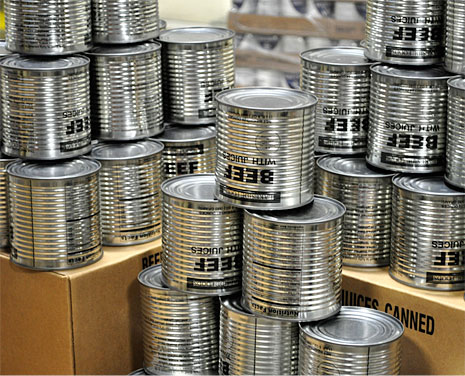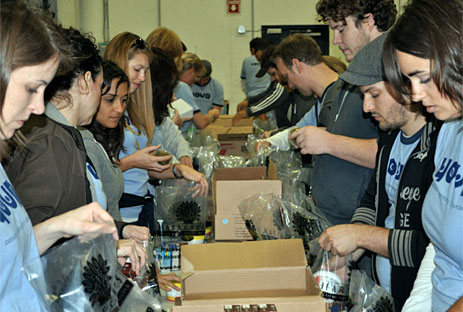 Mmmm … this is what’s for dinner? Photos: Beth BaderDinner Saturday night with my father-in-law is always “Steak Night.” And before he picks up his fork, he always says, “Wonder what the poor people are eating tonight?”
Mmmm … this is what’s for dinner? Photos: Beth BaderDinner Saturday night with my father-in-law is always “Steak Night.” And before he picks up his fork, he always says, “Wonder what the poor people are eating tonight?”
It’s a harmless statement, really. Kind of like my grandfather’s favorite explanation for how he takes his coffee: “Hot and dark like my women!” (Cringe.)
But if I ever did really wonder what the poor people are eating tonight, I don’t have to anymore. It’s “Beef.” As in, that very generic-looking can of commodity meat with no branding and no label. The ingredients: “Beef, salt.” The source of that meat is probably close to if not the same as the “beef” that ends up in the dog dish. I can’t say for sure, as the label gave no indication of what cut of beef it was or where it came from.
I do know, however, that THAT can is what “the poor people eat” because I, along with 20 friends and coworkers, packed more than a thousand grocery boxes for them at a recent volunteer day for Harvesters Community Food Network, Kansas City’s food bank. Each box contained a large can of a meat-like edible substance; two half-gallon bottles of tomato and orange juice, two boxes of cereal, a large can of milk, canned fruit and vegetables, and canned soup. Each box was sealed and labeled then stacked on a pallet with a hundred others. Each box represented exactly a week’s worth of food for a senior citizen who could not afford to eat otherwise.
Earlier in the day, our team also packed 1,300 “back-snacks” for school kids. The kids take these backpacks full of food home on weekends, when there is no school breakfast and lunch. For many, this is all the food they will get the whole weekend. There’s not much in that bag, and it’s not great food, but pretty similar to what most kids in America eat: milks, cereal, canned meals, snacks and bars, fruit cups.
 My coworkers and I lined up to pack boxes and bags of donated food,We had two teams working, packing over 4,000 of these kits for seniors and kids. Each day, volunteers come and do more. In other parts of the massive warehouse, teams are mobilized quickly to sort and distribute produce that is over-ripe and the day-old baked goods.
My coworkers and I lined up to pack boxes and bags of donated food,We had two teams working, packing over 4,000 of these kits for seniors and kids. Each day, volunteers come and do more. In other parts of the massive warehouse, teams are mobilized quickly to sort and distribute produce that is over-ripe and the day-old baked goods.
Mountains of food donated or purchased for cheap are stacked to the ceiling like a Costco on steroids. It seems like an endless food supply. But with more than 60,000 people fed per week from this one building, those shelves empty at an alarming rate. Armies of volunteers are needed weekly to keep up with the ever-increasing need as the number of food insecure in our nation rises.
And despite this massive effort, there are many who still go without, in Kasnas City and around the nation. In fact, some 100,000 children in my metropolitan area alone are food-insecure.
 A “back-snack” weekend food bag for hungry kids.If you’re not excited by the shop-til-you-drop messages of this holiday season — or even if you are, but want to do something meaningful as well, you’ve got lots of options:
A “back-snack” weekend food bag for hungry kids.If you’re not excited by the shop-til-you-drop messages of this holiday season — or even if you are, but want to do something meaningful as well, you’ve got lots of options:
- Donate food. But read this before cleaning out your pantry. The most needed items are not crusty old jars of roasted peppers or quince paste, but staples such as canned vegetables, canned fruit, boxed meals, canned meat, peanut butter, canned soup, and cereal (hot and cold).
- Make time. Take a day to give back and volunteer. Hefting boxes of cans and half-gallon jugs all day is one fine workout for the body and the soul.
- Advocate. The recently passed school-nutrition bill had first proposed taking money from food stamps to fuel the lunch program. Both serve the same needs, so that’s a bit like saying to a kid: “So, do you want to skip lunch or dinner today?” Write Congress and keep up with these kinds of legislation.
- Grow and gather. If those cans of food at the pantry bother you locavores and green thumbs, you can donate your garden’s harvest. You can also teach cooking and nutrition classes, organize harvest gleanings, or just coordinate with other gardeners for a larger donation.
- Spare a little cash. Food banks like Harvesters have special purchasing programs and can buy an unbelievable amount of food for the same dollars spent on those minestrone soups and cans of lima beans tossed in the donation bin.
- Walk a mile in someone’s hungry shoes. Understand what it is to experience that vague phrase “food insecurity” by taking the Food Stamp Challenge as a New Year’s resolution or family project — it would be a fantastic teaching experience for kids. All you have to do is vow to spend the same on groceries for one week as food-stamp recipients get. For a single-person household, that’s $50 for a week. A couple is $91.75, and a family of three is $131.50. And for the Challenge, that has to cover all your food, including fast food or dining out — and no subsisting on the stockpiled ground beef in the freezer. Note that these are the maximum food-stamp benefits available to recipients. The actual average benefit for individuals in the Midwest, for example, is approximately $20 per week.
Editor’s note: If you decide to take the Food Stamp Challenge — or already have — and want to write about it for Grist, drop Bonnie Powell a line.



